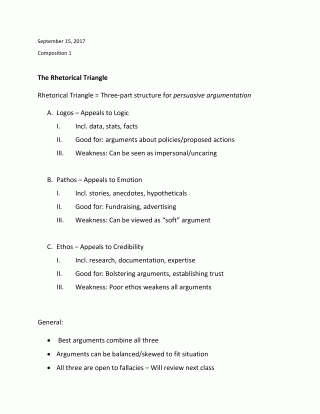Classroom Expectations
This resource was prepared by the Business Communications Lab at the Sam M. Walton College of Business
Overview
What do you expect from your professor in a class setting? And what does your professor expect from you? Students and professors both have expected roles to play in a classroom. These roles may be different from what you are accustomed to. For the best learning experience, we must understand what to expect from professors and what they are expecting from us. This can help you have a comfortable, productive learning experience. Each professor has their own habits and rules that guide how they organize their class. Still, we can generalize classroom expectations that are common in the American education system, allowing us to prepare for our roles as successful students.
Preparedness
At the beginning of each semester, your instructor will give you a syllabus. The syllabus is an implied agreement between teacher and students about course policies and schedule. By taking a course, you and the instructor both agree to follow the syllabus. The syllabus may be updated as the course progresses. Always know how to access a course’s syllabus throughout the semester. Most classes will require you to complete an outside reading or some other assignment before coming to class. Some classes will also ask you to complete small quizzes or exercises between class meetings. Listen for these announcements in class, but also consult your syllabus for information about what may be due for each class meeting. The syllabus will usually list a reading and assignment schedule. If you are unsure about what is due before class, look on the syllabus. In addition, make sure to look over notes from the previous session before coming to class. A class meeting will often build on a previous meeting, so it is smart to refresh yourself on the information the instructor has covered. Also, try to arrive to class a few minutes early. For a class to begin at the scheduled time, most instructors expect students to not only be present at the start time, but to be ready to work. This means having your notebook or laptop set up and being ready to take notes before the teacher formally begins class.
Lecture Structure
Class meetings often combine lecture and class discussion. Lecture style varies from teacher to teacher. Some teachers follow the book. Some ignore the book. Some teachers are serious, while some use humor. They may teach their own ideas or someone else’s. It is important to learn how your teacher structures their lectures, because every teacher has a personal style. In general, lectures begin by reviewing established information, which may come from assigned readings or previous classes. For this reason, it is good to review your notes and readings before class. A teacher will then connect new information to established information. Always try to understand how the new information connects to the old information. Most lectures have one main idea—an important idea the teacher wants you to really understand and remember. The main idea is sometimes called “the takeaway,” because it’s a single piece of information you can easily take with you when you leave. The main point will usually be introduced near the beginning or near the end of the lecture. Try to identify it in your notes. To help yourself analyze the course’s larger ideas, ask yourself: Why the information is being presented in this order? In a course, earlier lectures usually establish core concepts, while lectures later in the semester teach advanced concepts. Finally, American teachers often try to teach ideas rather than only answers. Remember this as you take your notes.
Taking Notes
Note-taking is just as important as reading and following a lecture. Good notes show the relationships between ideas. They contain both facts and concepts. You should make notes in class as well as when you are reading course materials outside of class. Teachers expect students to take productive notes, and may not feel obligated to review information that they assume students have put into their notes. Note-taking styles vary. What’s most important is that your note taking style serves you. After a quiz or examination, review your notes along with your graded work. Notice which questions you missed. Was this question covered in your notes? If so, ask yourself why did you not remember the information. If it was not covered, ask yourself why did it not end up in your notes. Adjust your note-taking and reviewing style so that you always have access to the most important information from a class. Your goal is not to transcribe a teacher’s lecture word-for-word. Remember that not everything a teacher says in class will be of equal importance. Your notes should focus on the most important information. Notice what the main idea of a lecture seems to be. Make sure your notes prioritize facts and concepts most related to the main idea. Also prioritize information that adds to or modifies established information from earlier in the lecture or the course. The notes you take should be succinct, meaning they are short enough to write quickly and detailed enough to remind you of a complete idea. Below are explanations of some common note-taking styles.
invisible
Outlining
 Here is a video explanation:
Here is a video explanation: Cornell Style Notes
Non-Linear Notes
Close Tabs
Class Discussion
Often, a class meeting is almost like a conversation. Most American professors expect and welcome student interaction, interjection, and sometimes even interruption. Sometimes a teacher will ask for student commentary. Other times, students may add to the conversation even when not specifically prompted by the instructor. In general, asking questions is the most productive way to contribute to the classroom conversation. Generally, you will signal you have a question to ask by raising your hand silently and making eye contact with your instructor. An instructor may call on you to speak, or may signal (verbally or non-verbally) that they will call on you once they have finished their thought. Once you have been acknowledged by the teacher, you may lower your hand. The best questions are related to the topic under discussion. You may ask questions for a few different reasons, such as general curiosity about the topic, clarification of incomplete or missed information, or a request for a specific example to illustrate a concept being discussed. You may also consider asking questions relating the discussion topic to established information from a previous class. Keep in mind that many teachers (though not all) consider it rude to interrupt without raising your hand. This applies when the instructor is speaking, but also when your classmates are speaking. Most instructors welcome discussion, but they expect to guide the discussion.
Recently Created Resources
Using ChatGPT Effectively and Ethically
Chat GPT is an AI-powered bot that can generate text based on prompts from a user. Like all tools, it is only as good as its user. ChatGPT can help users generate ideas quickly, create outlines and rough drafts, polish grammar and word choice, and function much like a...
Analyzing and Responding to a Case Study
Case study assignments can feel difficult, especially if this is your first time working on one. In this article, we’re going to discuss what a case study is and some tools you can use to help your assignment feel more manageable.
Managing Your Tone with Word Choice and Sentence Length
Tone denotes the perceived attitude of the writer toward the subject and their intended audience. One of the ways you can modulate your tone is through word choice and sentence length.




You must be logged in to post a comment.